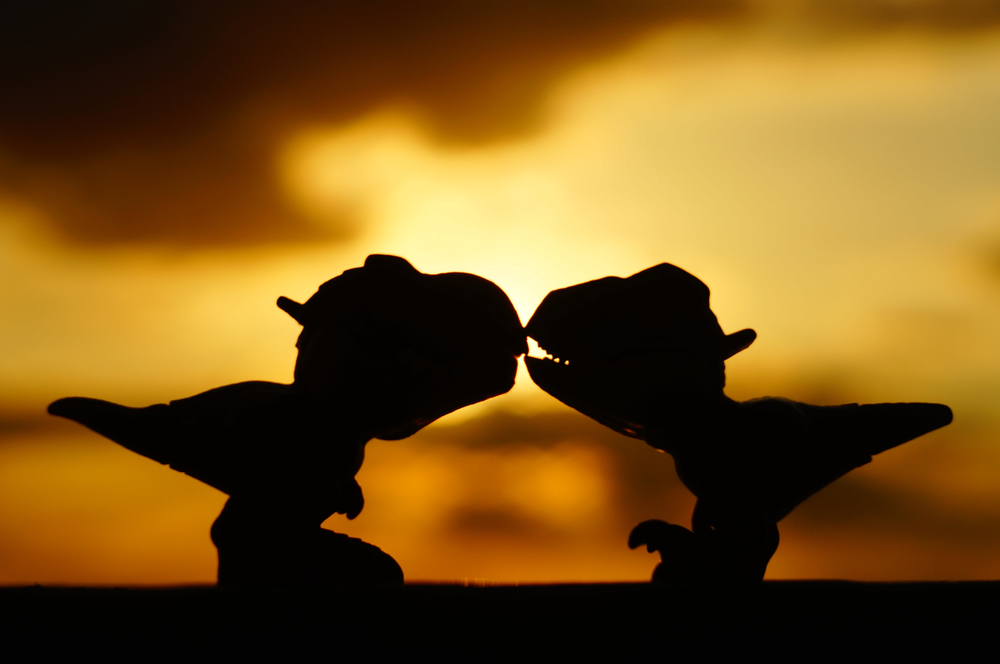
How did dinosaurs have sex? Sounds like the start of a risky prank. In the early years of paleontology it would have been considered beneath the dignity of the field to even place it a question. Nowadays, however, it is a perfectly legitimate subject to which paleontologists and paleobiologists have devoted years of patient study.
The problem is that science may never have a definitive answer to the question, because we honestly aren’t sure exactly how dinosaurs reproduced, or whether all dinosaurs mated in the same way, with the same biological equipment.
Of course, we have evidence that dinosaurs laid eggs, so we know about the tail (as it were) of the reproductive act. But how exactly did this process begin? What was the Jurassic spark that led to this egg?
Although researchers have found countless eggs and bones, soft tissue—including anything that could be a reproductive organ—doesn’t preserve well over millions of years and is therefore decidedly scarce in the fossil record. What’s more, experts still struggle to even tell the difference between male and female dinosaur remains. How can we make an educated guess about their breeding methods?
Read more: Male or female dinosaur? It is not easy to tell them apart
As it turns out, paleontologists have discovered some rare and tantalizing evidence that gives us a few clues about dinosaur mating practices. And by studying the modern descendants of the creatures that once ruled the planet, researchers have developed some pretty compelling theories about dinosaur sex lives.
Prelude to Fossils
(Credit: Catmando/Shutterstock)
For starters, we can reasonably assume that dinosaurs had mating rituals and physical signs to attract sexual partners, just as many creatures in the animal kingdom do today. For example, an abundance of dinosaurs, from Triceratops to Pachyrhinosaurusthere were rudders and horns which, while offering some defensive utility, could have played a role in the prehistoric mating game.
In addition to rivals using their horns to fight over a mate, prospective mates may have chosen each other based on the size, color, or intricate nature of the frills and horns. Likewise, since we now know that some dinosaurs had feathers, their plumage may also have served as a visual display of masculinity and good health, just as it is with birds today.
Speaking of birds, we also know that some modern bird mating practices involve what is known as a display or scraping ceremony. This form of courtship involves a male bird aggressively scraping the ground, apparently demonstrating to a potential female his strength and ability to dig a good nest for their potential offspring.
In 2016, paleontologists in Colorado found similar scrapings—except they were much larger than any modern bird could make, and embedded in rock 100 million years old. The researchers conclude that dinosaurs made them and that their resemblance to modern scratch displays is too great to be a coincidence. In all likelihood, this is evidence of a dinosaur mating ritual, the first of its kind ever discovered.
Sealed with a kiss?
(Credit: Yudhy Teguh Ariyantho/Shutterstock)
As for how dinosaurs actually had intercourse, the most common theory today comes again from our understanding of modern birds (as well as reptiles and amphibians). Almost all male and female birds possess what is known as a the cloacaa universal orifice that is used for both waste excretion and sexual reproduction (though probably not simultaneously).
When the cloaca-equipped creatures finally get down to business, they engage in what is inevitably called a cloacal kiss: they literally press their cloacae together and the male transfers sperm to the female, fertilizing her eggs. After a gestation period, the female lays these eggs from the same cloaca.
And there it is: the miracle of life. Paleontologists have hypothesized that dinosaurs probably reproduced in the same way. But again, with so little soft tissue preserved in the fossil record, this theory, logical and convincing as it is, lacked evidence.
Psittacosaurus A secret
Psittacosaurus fossil, Senckenberg Museum in Frankfurt. (Credit: Ghedoghedo/CC BY-SA 3.0/Wikimedia Commons)
At least that was until 2021, when a team of British and American paleontologists examined an extremely rare and well-preserved fossil of Psittacosaurusdistant relative of Triceratops who lived about 110 million years ago. This particular specimen had been discovered a few years earlier, with enough soft tissue remains that the researchers could see what they thought was the cloaca. After all, they reconstructed what was indeed a dinosaur’s cloaca, and found it to be similar to those seen in modern crocodiles, some of the closest living relatives of dinosaurs today.
Read more: Psittacosaurus Camouflage revealed
But even this astonishing find is not the last word on how dinosaurs were able to have sex. Yes, some (maybe even most) species may have made small dinosaurs by cloning their cloacae together. But others may have used more known methods and equipment. For example, some researchers suggest that just as ancient birds had penises (as well as some modern species, such as ducks), male dinosaurs could have been similarly endowed.
Unless and until other rare fossil evidence emerges that sheds more light on dinosaur sex lives, paleontologists—and any of us who want to ponder this question—will either have to leave further clear details to the imagination, or be enough to let the veil of privacy remain closed over this most intimate prehistoric moment.
Read more: Did all dinosaurs lay eggs?

